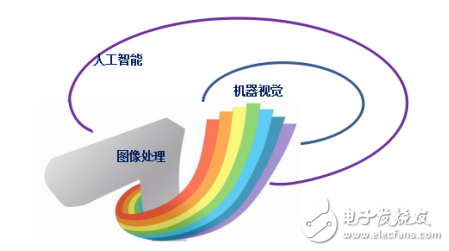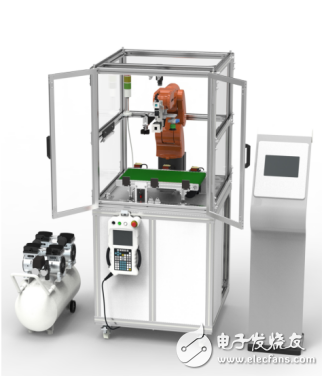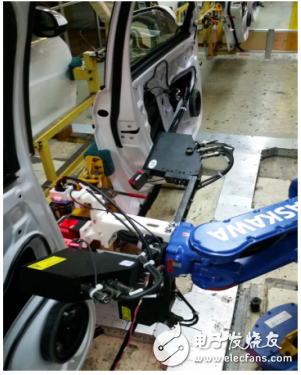Machine Vision (Machine Vision) is an important branch in the field of artificial intelligence that is developing rapidly. It is currently in a stage of continuous breakthrough and maturity. It is generally believed that machine vision "is an optical device and a non-contact sensor that automatically receives and processes an image of a real scene, and obtains the required information by analyzing the image or the device used to control the movement of the machine." It can be seen that intelligent image processing technology is used in the machine It holds a decisive position in vision.
Intelligent image processing refers to a type of computer-based image processing and analysis technology that is adaptive to various applications. It is an independent theoretical and technical field, but it is also a very important technical support in machine vision. The relationship between artificial intelligence, machine vision and intelligent image processing technology is shown in Figure 1.

Figure 1 The supporting role of intelligent image processing
Machine vision with intelligent image processing function is equivalent to that people give the machine intelligence while pressing the eyes of the machine, so that the machine can "see" and "see accurately", which can replace or even beat the human eye to make measurements and Judgment, so that the machine vision system can achieve high-resolution and high-speed control. Moreover, the machine vision system has no contact with the detected object, which is safe and reliable.
1. Machine vision technology
The origin of machine vision can be traced back to the research of the image processing of the multi-faceted bulk wood world by American scholar LR Roberts in the 1960s, and the establishment of the "Machine Vision" course in the artificial intelligence laboratory of the Massachusetts Institute of Technology (MIT) in the 1970s. By the 1980s, a global research boom in machine vision began to emerge, and some application systems based on machine vision appeared. After the 1990s, with the rapid development of computer and semiconductor technology, the theory and application of machine vision have been further developed.
After entering the 21st century, the development speed of machine vision technology is faster, and it has been applied in many fields on a large scale, such as intelligent manufacturing, intelligent transportation, medical and health, security monitoring and other fields. At present, with the rise of the artificial intelligence wave, machine vision technology is in a new stage of continuous breakthrough and maturity.
In China, the research and application of machine vision began in the 1990s. Starting from tracking foreign brand products, after more than 20 years of efforts, domestic machine vision has grown from scratch, from weak to strong. Not only has the theoretical research progressed rapidly, but also some competitive companies and products have appeared. It is estimated that with the continuous deepening of research, development and promotion of machine vision in China, catching up and surpassing the world level is no longer out of reach.
Common machine vision systems can be divided into two categories, one is based on computers, such as industrial computers or PCs, and the other is more compact embedded devices. The typical machine vision system based on industrial computer mainly includes: optical system, camera and industrial computer (including image acquisition, image processing and analysis, control / communication) and other units, as shown in Figure 2. The machine vision system requires accurate, fast and stable algorithms for the core image processing. At the same time, it also requires low implementation cost and easy upgrade.

Figure 2 Examples of machine vision systems
2. Intelligent image processing technology
The machine vision image processing system calculates and analyzes the digital image signals on site according to specific application requirements, and controls the actions of field devices according to the obtained processing results.
(1) Image acquisition
Image acquisition is the process of acquiring scene images from the work site. It is the first step of machine vision. Most of the acquisition tools are CCD or CMOS cameras or video cameras. The camera collects a single image, and the camera can collect continuous live images. As far as an image is concerned, it is actually a projection of a three-dimensional scene on a two-dimensional image plane, and the color (luminance and chroma) of a certain point in the image is a reflection of the corresponding point color in the scene. This is where we can use captured images to replace the real scene.
If the camera is an analog signal output, the analog image signal needs to be digitized and sent to a computer (including embedded system) for processing. Most cameras can now output digital image signals directly, eliminating the step of analog-to-digital conversion. Not only that, the digital output interface of the camera is also standardized, such as USB, VGA, 1394, HDMI, WiFi, Blue Tooth interface, etc., can be directly sent to the computer for processing, so as not to add an image between the image output and the computer The trouble with the capture card. Subsequent image processing work is often carried out in software by a computer or embedded system.
(2) Image preprocessing
Due to the influence of equipment and environmental factors, the collected digital scene images are often subject to various degrees of interference, such as noise, geometric deformation, color imbalance, etc., which will hinder the subsequent processing. To this end, the collected images must be preprocessed. Common preprocessing includes noise elimination, geometric correction, histogram equalization and other processing.
Usually use time domain or frequency domain filtering method to remove noise in the image; use geometric transformation to correct the geometric distortion of the image; use histogram equalization, homomorphic filtering and other methods to reduce the color deviation of the image. In short, through this series of image preprocessing techniques, the processed images are "processed" to provide "better" and "more useful" images for volume machine vision applications.
(3) Image segmentation
Image segmentation is to divide the image into characteristic regions according to the application requirements, and extract the target of interest from it. Common features in images are grayscale, color, texture, edges, corners, etc. For example, the image of the automobile assembly line is segmented, divided into the background area and the workpiece area, and provided to the subsequent processing unit for processing the workpiece mounting portion.
Image segmentation has been a difficult problem in image processing for many years. There have been a wide variety of segmentation algorithms, but the results are often not ideal. Recently, people have used deep learning methods based on neural networks to perform image segmentation, and their performance is better than traditional algorithms.
(4) Target identification and classification
In industries such as manufacturing or security, machine vision cannot do without identifying and classifying the target of the input image, so as to complete subsequent judgments and operations on this basis. Recognition and classification techniques have many similarities. Often, after target recognition is complete, the category of the target is clear. Recently, image recognition technology is transcending traditional methods to form intelligent image recognition methods with neural networks as the mainstream, such as convolutional neural networks (CNN), regression neural networks (RNN) and other methods with superior performance.
(5) Target positioning and measurement
In intelligent manufacturing, the most common work is to install the target workpiece, but often need to locate the target before installation, and also need to measure the target after installation. Both installation and measurement need to maintain high accuracy and speed, such as millimeter-level accuracy (or even smaller), millisecond-level speed. This high-precision, high-speed positioning and measurement is difficult to rely on the usual mechanical or manual methods. In machine vision, the image processing method is used to process the installation site images, according to the complex mapping relationship between the target and the image, so as to quickly and accurately complete the positioning and measurement tasks.
(6) Target detection and tracking
Moving object detection and tracking in image processing is to detect whether there is a moving object in the scene image captured by the camera in real time, and predict its next moving direction and trend, that is, tracking. And timely submit these motion data to the subsequent analysis and control processing to form corresponding control actions. A single camera is generally used for image acquisition. If necessary, two cameras can be used to imitate human binocular vision to obtain stereoscopic information of the scene, which is more conducive to target detection and tracking processing.
3. Application of machine vision
As shown in Figure 3, machine vision is widely used, such as security, manufacturing, education, publishing, medical, transportation, and military fields. In the application of these machine amounts, intelligent image processing is indispensable, only a few of them are briefly introduced here.

Figure 3 Common machine vision applications
(1) Intelligent manufacturing
In order to achieve the grand goal of China's intelligent manufacturing 2025, machine vision is indispensable. For example, Guangdong Xuntong Technology Co., Ltd. (hereinafter referred to as "Xuntong Technology"), which has been a leader in intelligent image processing, has developed a machine vision analyzer platform for this demand, as shown in Figure 4. Among them, Xuntong Technology developed a system for automatic positioning, detection and identification of door stoppers for an assembly line of a well-known automobile manufacturer, as shown in Figure 5. The system automatically detects whether the model is correct and the positioning is accurate through intelligent image recognition. It completely replaces manual operation and the detection accuracy rate reaches 100%. Previously, each worker required 4 workers to inspect and locate 16 types of stoppers with their eyes. Employees not only easily fatigued, but also made errors frequently.

Figure 4 Xuntong Machine Vision Analyzer Platform

Figure 5 Workpiece identification / positioning detection system (onsite)
(2) Educational examination
Examination papers are often found to affect students' examinations due to typographic or printing errors. Using intelligent image processing technology, the machine automatically compares the printed test papers with the original test papers. If there is any inconsistency, it will automatically prompt and report to the police. It can only be passed before the complete replacement Check the test paper manually.
(3) Publishing and printing
Similar to educational examinations, professional publishing houses have many types and quantities of printed books, newspapers and magazines, and undertake product packaging and promotional materials from enterprises, and often make mistakes in typesetting and printing. To this end, many professionals need to arrange for proofreading, which consumes a lot of capital and time. By using intelligent image processing technology for automatic proofreading, it not only improves proofreading accuracy, but also shortens proofreading time, reduces printing costs, and shortens the delivery cycle of publications.
(4) Security monitoring
This is an area that is currently receiving much attention from machine vision. Machine vision breaks the limitations of traditional video surveillance systems and increases the intelligence of the system, enabling intelligent video analysis to be gradually realized. Taking video surveillance in public places as an example, through the use of machine vision technology, automatic detection, face recognition, and real-time tracking of suspicious characters can be achieved, and if necessary, multiple cameras can be tracked continuously, and alarms can be issued to store on-site information.
(5) Intelligent transportation
Machine vision has a wide range of applications in transportation. For example, on highways and at checkpoints, the vehicle types and license plates are identified, and even the violations of vehicles are identified. Analyze the driver's facial image on the car to determine whether the driver is in a fatigued driving state. As another example, driverless cars use machine vision technology to use camera, laser / millimeter wave / ultrasonic radar, GPS, etc. to sense road environment information, and automatically plan and control the safe driving of vehicles.
According to statistics, the market size of the global machine vision system was about US $ 4.6 billion in 2016, about US $ 5 billion in 2017, and is expected to reach US $ 5.5 billion in 2018, with an annual growth rate of about 10%. The growth of China's machine vision market began in 2010, with a market size of approximately 6.8 billion yuan in 2017. It is expected to reach 78 billion yuan by 2020, and the market growth rate will exceed 100%.
4. Technical bottleneck and future development
In the development of intelligent image processing technology of machine vision, there are still many technical bottlenecks, such as:
(1) Stability: A certain processing method often performs well in research and development, but in complex and changing application environments, problems occur from time to time. For example, in the face recognition system, the recognition rate can be as high as 95% or more when the target is matched, but in the actual monitoring environment, the recognition rate will be greatly reduced.
(2) Real-time: If the image acquisition speed and processing speed are slow, coupled with the newly introduced deep learning algorithm, the difficulty of real-time processing of the system is increased, and it cannot keep up with the rhythm of machine operation and control.
(3) Accuracy: The machine vision system requires the accuracy of image recognition and measurement to be close to 100%. Any small error may bring unpredictable consequences. For example, the error of target positioning will make the assembled equipment not meet the requirements.
(4) System capabilities: The current embedded image processing system has problems such as insufficient computing power of the chip and limited storage space, and often cannot meet image processing operations with a large amount of calculations, such as iterative operations of neural networks and large-scale matrix operations Wait.
The future development of intelligent image processing in machine vision is mainly reflected in the following aspects:
(1) Algorithms: Traditional algorithms continue to make breakthroughs. The new wave of artificial intelligence has brought many new image processing algorithms with excellent performance, such as deep learning (DL), convolutional neural networks (CNN), and generation of adversarial networks. (GAN), wait.
(2) Real-time: There are more hardware platforms supported by novel structures, sufficient resources, and fast operations, such as computers based on multi-CPU and multi-GPU parallel processing structures, and mass storage units.
(3) Embedded: New high-speed signal processor array, ultra-large-scale FPGA chip.
(4) Fusion processing: from single image sensor development to multi-sensor (multi-viewpoint) fusion processing, it is possible to obtain on-site information more fully. It can also integrate multiple types of sensors, such as image sensors, sound sensors, temperature sensors, etc., to complete localization, recognition and measurement of on-site targets.
In short, neither "Made in China 2025" or "Industry 4.0" can do without artificial intelligence and computer vision, and intelligent image processing is the core technology of machine vision. Promote the rapid development of machine vision.
What`s the main features appear into your mind when you look yoga laptop? Lightweight, super thinner, touch screen, 360 rotating, smaller size, like as notebook? You are right, that`s the main reasons why some people also called it as laptop yoga slim or yoga notebook. To OS, just same as Education Laptop-windows operating system, so you can see many windows yoga laptop at the market around the world. In fact, this intel yoga laptop usually is designed for normal jobs, like basic WPS, Photoshop, video or music editing, online learning, shopping, presentation when on a business trip, etc. At our store, you can see 11.6 inch n5100 360 Laptop in metal, 13.3 inch 360 flip laptop, and 14 inch 360 degree rotating laptop, etc. The people who take business trips often or prefer fashion design should like this type device.
There are education laptop also, like 14.1 inch Student Laptop for Hope or government Projects, 15.6 inch competitive celeron business laptop for normal business works, 15 inch 10th or 11th Gaming Laptop for heavier tasks, like teachers, high or university students, etc, 16.1 inch i7 16gb ram 4gb graphics laptop for engineering student, etc
Any other question or other requirements, just contact us freely.
Yoga Laptop,Laptop Yoga Slim,Yoga Notebook,Intel Yoga Laptop,Windows Yoga Laptop
Henan Shuyi Electronics Co., Ltd. , https://www.shuyicustomtablet.com
